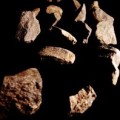×
Nós usamos os cookies para ajudar a melhorar o LingQ. Ao visitar o site, você concorda com a nossa
política de cookies.
Pieces of stars fall to earth every day.
When these fragments fail to disintegrate in the atmosphere and plunge into the ocean or strike land, they are called meteorites.
It is estimated that one meteorite of at least 100 grams strikes Canadian territory every day.
The Canadian Shield is marked by many meteorite craters, or astroblemes, which are among the largest and best preserved in the world.
According to a number of scientists, the extinctions that have punctuated the history of life on earth may be attributable to the effects of enormous meteorites.
Some think, for example, that the meteorite five kilometres in diameter that punched out the Manicouagan Crater in Quebec was responsible for the sudden disappearance of many species some 213 million years ago.
With this in mind, we can count ourselves fortunate that the meteorite that crashed in January 2000 near Carcross, Yukon was only about two metres in diameter.
Pieces of stars fall to earth every day. When these fragments fail to disintegrate in the atmosphere and plunge into the ocean or strike land, they are called meteorites. It is estimated that one meteorite of at least 100 grams strikes Canadian territory every day.
The Canadian Shield is marked by many meteorite craters, or astroblemes, which are among the largest and best preserved in the world. According to a number of scientists, the extinctions that have punctuated the history of life on earth may be attributable to the effects of enormous meteorites. Some think, for example, that the meteorite five kilometres in diameter that punched out the Manicouagan Crater in Quebec was responsible for the sudden disappearance of many species some 213 million years ago. With this in mind, we can count ourselves fortunate that the meteorite that crashed in January 2000 near Carcross, Yukon was only about two metres in diameter.

